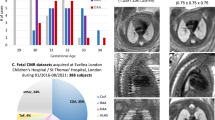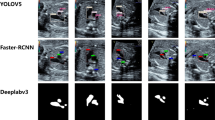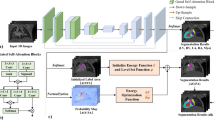Abstract
Congenital heart disease (CHD) encompasses a range of cardiac malformations present from birth, representing the leading congenital diagnosis. 3D volumetric reconstructions of T2w black blood fetal MRI provide optimal vessel visualisation, supporting prenatal CHD diagnosis, a key step for optimal patient management. We present a framework for automated multi-class fetal vessel segmentation in the setting where binary manual labels of the vessels region of interest (ROI) are available for training, as well as a multi-class labelled atlas.
We combine deep learning label propagation from multi-class labelled condition-specific atlases with 3D Attention U-Net segmentation to achieve the desired multi-class output. We train a single network to segment 12 fetal cardiac vessels for three distinct aortic arch anomalies (double aortic arch, right aortic arch, and suspected coarctation of the aorta). Our segmentation network is trained by combination of a multi-class loss, which uses the propagated multi-class labels; and a binary loss which uses binary labels generated by expert clinicians.
Our proposed method outperforms label propagation in accuracy of vessel segmentation, while succeeding in segmenting the anomaly area of all three CHD diagnoses included, achieving a 100% vessel detection rate.
Access this chapter
Tax calculation will be finalised at checkout
Purchases are for personal use only
Similar content being viewed by others
References
Arafati, A., et al.: Artificial intelligence in pediatric and adult congenital cardiac MRI: an unmet clinical need. Cardiovasc. Diagn. Ther. 9(Suppl 2), S310 (2019)
Balakrishnan, G., Zhao, A., Sabuncu, M.R., Guttag, J., Dalca, A.V.: VoxelMorph: a learning framework for deformable medical image registration. IEEE Trans. Med. Imaging 38(8), 1788–1800 (2019)
Dinsdale, N.K., Jenkinson, M., Namburete, A.I.L.: Spatial warping network for 3D segmentation of the hippocampus in MR images. In: Shen, D., et al. (eds.) MICCAI 2019. LNCS, vol. 11766, pp. 284–291. Springer, Cham (2019). https://doi.org/10.1007/978-3-030-32248-9_32
Grigorescu, I., et al.: Diffusion tensor driven image registration: a deep learning approach. In: Špiclin, Ž, McClelland, J., Kybic, J., Goksel, O. (eds.) WBIR 2020. LNCS, vol. 12120, pp. 131–140. Springer, Cham (2020). https://doi.org/10.1007/978-3-030-50120-4_13
Hatamizadeh, A., et al.: UNETR: transformers for 3D medical image segmentation. In: Proceedings of the IEEE/CVF Winter Conference on Applications of Computer Vision, pp. 574–584 (2022)
Kainz, B., et al.: Fast volume reconstruction from motion corrupted stacks of 2D slices. IEEE Trans. Med. Imaging 34(9), 1901–1913 (2015)
Kuklisova-Murgasova, M., Quaghebeur, G., Rutherford, M.A., Hajnal, J.V., Schnabel, J.A.: Reconstruction of fetal brain MRI with intensity matching and complete outlier removal. Med. Image Anal. 16(8), 1550–1564 (2012)
Lloyd, D.F., et al.: Three-dimensional visualisation of the fetal heart using prenatal MRI with motion-corrected slice-volume registration: a prospective, single-centre cohort study. The Lancet 393(10181), 1619–1627 (2019)
Mendis, S., Puska, P., Norrving, B., Organization, W.H., et al.: Global Atlas on Cardiovascular Disease Prevention and Control. World Health Organization (2011)
Oktay, O., et al.: Attention U-Net: learning where to look for the pancreas. arXiv preprint arXiv:1804.03999 (2018)
Pace, D.F., et al.: Iterative segmentation from limited training data: applications to congenital heart disease. In: Stoyanov, D., et al. (eds.) DLMIA/ML-CDS -2018. LNCS, vol. 11045, pp. 334–342. Springer, Cham (2018). https://doi.org/10.1007/978-3-030-00889-5_38
Peng, J., Wang, Y.: Medical image segmentation with limited supervision: a review of deep network models. IEEE Access 9, 36827–36851 (2021)
Rezaei, M., Yang, H., Meinel, C.: Whole heart and great vessel segmentation with context-aware of generative adversarial networks. In: Maier, A., Deserno, T., Handels, H., Maier-Hein, K., Palm, C., Tolxdorff, T. (eds.) Bildverarbeitung für die Medizin 2018. I, pp. 353–358. Springer, Heidelberg (2018). https://doi.org/10.1007/978-3-662-56537-7_89
Ronneberger, O., Fischer, P., Brox, T.: U-Net: convolutional networks for biomedical image segmentation. In: Navab, N., Hornegger, J., Wells, W.M., Frangi, A.F. (eds.) MICCAI 2015. LNCS, vol. 9351, pp. 234–241. Springer, Cham (2015). https://doi.org/10.1007/978-3-319-24574-4_28
Salehi, S.S.M., et al.: Real-time automatic fetal brain extraction in fetal MRI by deep learning. In: 2018 IEEE 15th International Symposium on Biomedical Imaging (ISBI 2018), pp. 720–724. IEEE (2018)
Sinclair, M., et al.: Atlas-ISTN: joint segmentation, registration and atlas construction with image-and-spatial transformer networks. Med. Image Anal. 78, 102383 (2022)
Uus, A., et al.: 3D UNet with GAN discriminator for robust localisation of the fetal brain and trunk in MRI with partial coverage of the fetal body. BioRxiv (2021)
Uus, A., et al.: 3D MRI atlases of congenital aortic arch anomalies and normal fetal heart: application to automated multi-label segmentation. BioRxiv (2022)
Uus, A., et al.: Deformable slice-to-volume registration for motion correction of fetal body and placenta MRI. IEEE Trans. Med. Imaging 39(9), 2750–2759 (2020)
Xu, Z., Niethammer, M.: DeepAtlas: joint semi-supervised learning of image registration and segmentation. In: Shen, D., et al. (eds.) MICCAI 2019. LNCS, vol. 11765, pp. 420–429. Springer, Cham (2019). https://doi.org/10.1007/978-3-030-32245-8_47
Yu, L., Yang, X., Qin, J., Heng, P.-A.: 3D FractalNet: dense volumetric segmentation for cardiovascular MRI volumes. In: Zuluaga, M.A., Bhatia, K., Kainz, B., Moghari, M.H., Pace, D.F. (eds.) RAMBO/HVSMR -2016. LNCS, vol. 10129, pp. 103–110. Springer, Cham (2017). https://doi.org/10.1007/978-3-319-52280-7_10
Yushkevich, P.A., et al.: User-guided 3D active contour segmentation of anatomical structures: significantly improved efficiency and reliability. Neuroimage 31(3), 1116–1128 (2006)
Zhao, A., Balakrishnan, G., Durand, F., Guttag, J.V., Dalca, A.V.: Data augmentation using learned transformations for one-shot medical image segmentation. In: Proceedings of the IEEE/CVF Conference on Computer Vision and Pattern Recognition, pp. 8543–8553 (2019)
Acknowledgements
We would like to acknowledge funding from the EPSRC Centre for Doctoral Training in Smart Medical Imaging (EP/S022104/1).
We thank everyone who was involved in the acquisition and examination of the datasets and all participating mothers. This work was supported by the Rosetrees Trust [A2725], the Wellcome/EPSRC Centre for Medical Engineering at King’s College London [WT 203148/Z/16/Z], the Wellcome Trust and EPSRC IEH award [102431] for the iFIND project, the NIHR Clinical Research Facility (CRF) at Guy’s and St Thomas’ and by the National Institute for Health Research Biomedical Research Centre based at Guy’s and St Thomas’ NHS Foundation Trust and King’s College London. The views expressed are those of the authors and not necessarily those of the NHS, the NIHR or the Department of Health.
Author information
Authors and Affiliations
Corresponding author
Editor information
Editors and Affiliations
Rights and permissions
Copyright information
© 2022 The Author(s), under exclusive license to Springer Nature Switzerland AG
About this paper
Cite this paper
Ramirez Gilliland, P. et al. (2022). Automated Multi-class Fetal Cardiac Vessel Segmentation in Aortic Arch Anomalies Using T2-Weighted 3D Fetal MRI. In: Licandro, R., Melbourne, A., Abaci Turk, E., Macgowan, C., Hutter, J. (eds) Perinatal, Preterm and Paediatric Image Analysis. PIPPI 2022. Lecture Notes in Computer Science, vol 13575. Springer, Cham. https://doi.org/10.1007/978-3-031-17117-8_8
Download citation
DOI: https://doi.org/10.1007/978-3-031-17117-8_8
Published:
Publisher Name: Springer, Cham
Print ISBN: 978-3-031-17116-1
Online ISBN: 978-3-031-17117-8
eBook Packages: Computer ScienceComputer Science (R0)





